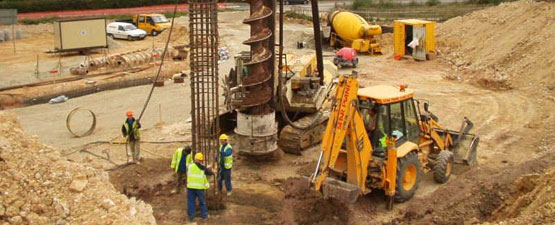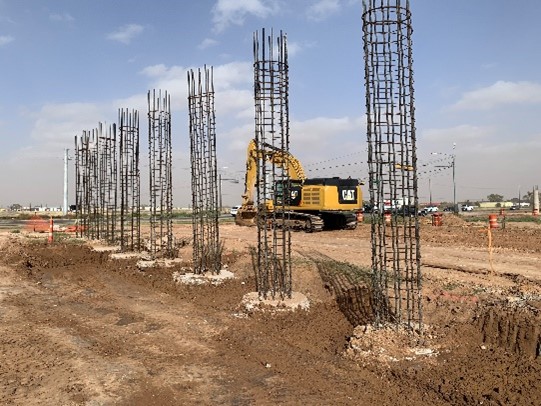Project Geotechnical Engineer Know-how for Large-Scale Developments
Project Geotechnical Engineer Know-how for Large-Scale Developments
Blog Article
How Consulting Engineers Enhance Geotechnical Design Projects: Insights Into Their Know-how, Methods, and Collaborative Approaches
Consulting engineers are pivotal in boosting geotechnical design projects, using their specialized understanding to navigate the intricacies of subsurface conditions. Their methodologies incorporate a series of site examination techniques, consisting of Requirement Penetration Examinations (SPT) and Cone Penetration Examinations (CPT), which notify crucial choices throughout the design and building and construction phases. Furthermore, their joint methods foster interaction among varied job stakeholders, ultimately forming the project's trajectory. As we check out the complex duties these professionals play, it ends up being clear that their payments extend past technological expertise, triggering a more detailed consider the implications for job success.
Role of Consulting Engineers
The knowledge of getting in touch with engineers in geotechnical engineering is essential to the effective implementation of construction projects. These experts play a crucial duty in assessing soil and rock buildings, which are crucial aspects affecting style and building and construction choices. By performing thorough site investigations, speaking with engineers collect vital data that notifies the style process, making sure jobs are improved steady and appropriate ground.
Consulting designers likewise supply very useful understandings right into risk monitoring (geotechnical geologist). They recognize potential geotechnical risks, such as landslides, dirt liquefaction, and negotiation issues, enabling stakeholders to carry out reliable reduction approaches. Their expertise help in maximizing structure styles, which can result in significant cost financial savings and boosted security
Additionally, consulting designers offer as a crucial link in between job owners, designers, and specialists. Their ability to equate complicated geotechnical information right into actionable referrals fosters partnership and assists in notified decision-making throughout the job lifecycle. This multidisciplinary strategy not only improves job performance however likewise makes sure compliance with regulative criteria and finest practices.
Secret Methods in Geotechnical Engineering

One primary approach is site examination, which involves conducting field tests and lab evaluations to gather information on subsurface problems. Strategies such as Requirement Penetration Testing (SPT) and Cone Infiltration Screening (CPT) are commonly utilized to examine dirt stratigraphy and toughness. Furthermore, geophysical approaches, consisting of seismic and electrical resistivity surveys, offer non-invasive means to analyze subsurface qualities.
Another vital approach is numerical modeling, which allows engineers to mimic different circumstances and anticipate exactly how soil-structure communications will certainly behave under various loading conditions. Finite Aspect Analysis (FEA) is a common method used in this context.
Moreover, the style of structures, keeping structures, and earthworks counts heavily on these approaches - geotechnical geologist. By incorporating sophisticated analytical tools with area data, seeking advice from engineers can develop customized options that address specific their website job obstacles, ultimately adding to the security and security of construction projects
Importance of Soil Evaluation
Dirt evaluation acts as a fundamental aspect in geotechnical engineering, supplying essential insights right into the physical and chemical homes of soil required for efficient construction planning. Comprehending dirt features is critical for determining its load-bearing ability, drain actions, and capacity for negotiation or instability. In-depth dirt investigations, consisting of sampling and laboratory testing, assistance recognize criteria such as dirt type, dampness content, density, and shear toughness.
These evaluations educate the selection of suitable construction techniques and materials, ultimately influencing project safety and long life. For example, natural soils may require various structure layouts contrasted to granular dirts, requiring customized engineering remedies. Dirt evaluation help in determining pollutants that might position dangers to human health and wellness or the atmosphere, enabling for the advancement of mitigation techniques.
Integrating dirt analysis right into the onset of task development helps to minimize unexpected challenges, making certain that engineers can anticipate and attend to prospective issues prior to they intensify. By developing an extensive understanding of the website conditions, speaking with designers can maximize design efficiency and decrease prices, thus boosting the overall success of geotechnical design tasks.
Joint Approaches in Projects
Effective geotechnical projects commonly pivot on collective approaches that bring with each other diverse know-how from various techniques. Efficient collaboration amongst speaking with designers, geologists, ecological scientists, and building and try this out construction professionals is critical for attending to complex difficulties and optimizing job outcomes. By leveraging the special abilities and understanding of each group member, jobs can take advantage of an alternative understanding of the site problems, governing demands, and design constraints.
Routine interaction and interdisciplinary meetings assist in the sharing of understandings and foster a culture of synergy. These collaborative efforts allow the recognition of potential dangers early in the task lifecycle, enabling timely reduction strategies. Incorporating comments from stakeholders, consisting of neighborhood areas and regulatory agencies, guarantees that all perspectives are considered, enhancing project acceptance and compliance.
In addition, the assimilation of innovative technologies, such as Geographic Info Solution (GIS) and Building Info Modeling (BIM), further enhances collaboration. These tools allow for the real-time sharing of data and visualization of geotechnical conditions, advertising educated decision-making. Inevitably, a joint strategy not just simplifies task implementation however likewise lays the foundation for innovative remedies to intricate geotechnical design difficulties.
Influence On Project Outcomes

Consulting engineers use advanced methods such as risk evaluation and predictive modeling, which improve the precision of job projections. Their ability to incorporate innovative innovations, like geotechnical instrumentation and information analytics, even more improves the design and building procedures. Therefore, jobs experience boosted effectiveness, minimized costs, and reduced hold-ups.
Moreover, promoting efficient communication and partnership among staff member boosts problem-solving capacities. When challenges develop, a united front enables speedy recognition of solutions, stopping potential obstacles. Eventually, the collaborative efforts of seeking advice from engineers contribute to better Visit Your URL end results, ensuring that projects satisfy both regulative standards and customer assumptions.
Conclusion

Report this page